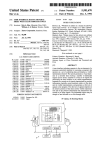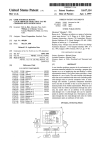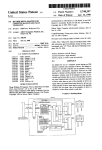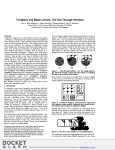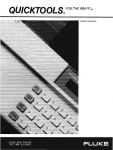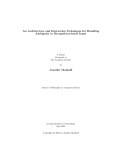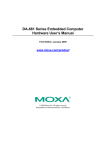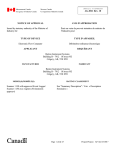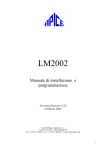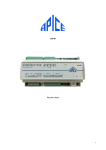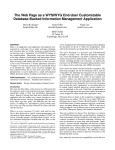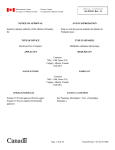Download MEMORY I IFILE STORAGE`
Transcript
‘
{1300579375211
United States Patent [19]
[11]
[45]
Buxton et al.
[54] USER INTERFACE HAVING
SIMULTANEOUSLY MOVABLE TOOLS AND
CURSOR
Patent Number:
Date of Patent:
‘
5,798,752
Aug. 25, 1998
5,287,417
2/1994 Eller et al. .............................. .. 382/41
5,341,466
8/1994 Perlin et al. ...... ..
5.381.158
1/1995 Takahara et al. ............. ..
. 395/139
345/156
OTHER PUBLICATIONS
[75] Inventors: Willaim A. S. Bnxton. Toronto.
Canada; Eric A. Bier. Mountain View.
Calif.
Canvas 3.0 User Guide: Chapter 1 ("The Fundamentals”). p.
2; and Section 19 (Reference), pp. 14-18. 59-60. 69-70.
90-91. 97-98. 100-102. 130. 150-151. 171-172. 173-174.
181-182. 189-197. 300 (Jun. 15. 1991 (Deneba Software.
[73] Assignee: Xerox Corporation. Stamford. Conn.
Miami. FL)).
[21] Appl. N0.: 398,420
[22] Filed:
Bartlett. Joel F. ‘Transparent Controls for Interactive Graph
ics.” WRL Technical Note TN-30. Digital Equipment Cor
poration. Jul. 1992. pp. 1-9.
Feb. 27, 1995
Brown et al.. “Windows on tablets as a means of achieving
Related US. Application Data
[63]
Continuation of Ser. No. 95,591, Jul. 21, 1993, abandoned.
[51]
[52]
[58]
Int. Cl.6 ..................................................... .. G09G 5/08
US. Cl. ......................... .. 345/146; 345/113; 345/157
Field of Search ................................... .. 345/145. 146.
345/113, 156. 161. 163. 167. 157; 395/159
[56]
virtual input devices.” In D. Diaper et al. (Eds). Human
-Computer lnteraction—lnteract ’90. Amsterdam: Elsevier
Science Publishers B.V. (North Holland). 675-681 ( 1990).
Hardock. Gary. “Design issues for line-driven text editing/
Annotation Systems." 11715 Graphics Interface 1991. 3-7
Jun. 1991. Calgary (1991) Toronto. ON. CA. pp. 77-84.
Macintosh “Macpaint”, 1983.
(List continued on next page.)
References Cited
Primary Examiner-Regina Liang
U.S. PATENT DOCUMENTS
Re. 32,632
3/1988 Atkinson ............................... .. 340/709
4,555,775
1l/1985
4,622,545
11/1986 Atkinson .......... ..
Pike ........ ..
340/747
4,686,522
8/1987 Hernandez et al.
345/146
4,748,441
5/1988
Brzezinski
.. 364/900
. . . . . . . ..
. . . ..
4,788,538 11/1988 Klein et al.
4,827,253
5/1989 Maltz ....... ..
4,896,291
4,910,683
1/1990 Gest et a1.
3/1990 Bishop et a1. .
4,917,516
4/1990 Retter ....... ..
4,931,783
6/1990
4,982,343
5,157,384
5,204,947
Atkinson
Attorney Agent, or Firm—Townsend and Townsend and
Crew LLP
processor-controlled machine for executing a program that
345/113
operates on a set of underlying data and displays a visible
representation thereof. The user simultaneously and inde
pendently moves the tools with one hand. normally the
non-dominant hand (e.g.. a right-handed user’s left hand)
. .. .
345/146
and operates on the visible representation with the other.
.. 345/113
. 340/706
. 345/146
the input devices include a trackball for positioning the tools
345/146
and a mouse for positioning a cursor and initiating actions.
5,250,929 10/1993 Ho?‘man et al
Bateman et a]
A user interface technique operates in the environment of a
340/747
. 364/900
. 364/518
. . . ..
1/1991 Hourvilz et al
10/1992 Greanias et a1
4/1993 Bernstein et a1
ABSTRACT
345/161
345/163
. . .. . .. .
[57]
5,276,797
1/1994
. . . ..
$283,560
2/1994 Bartlett .................................. .. 345/902
nonnally the dominant hand. In a speci?c implementation.
345/145
12
27 Claims, 16 Drawing Sheets
25
PROCESSOHI l KEYBOARD I
15
17
,20
MEMORY I IFILE STORAGE’
5,798,752
Page 2
OTHER PUBLICATIONS
Eric A. Bier and Maureen C. Stone. Snap-Dragging. In
Proceedings of Siggraph ’86 (Dallas. Aug.). Computer
Graphics. vol. 20. No. 4. ACM. 1986. pp. 233-240.
Eric A. Bier. Snap-Dragging: Interactive Geometric Design
J. K. Ousterhout. Tcl: An Embeddable Command Language.
In winter USENIX Conference Proceedings. 1990. pp.
133-146.
Ken Pier. Eric A. Bier. and Maureen C. Stone. An Introduc
tion to Gargoyle: An Interactive Illustration Tool. Xerox
in Two and Three Dimensions. Xerox PARC Technical
PARC Technical Report EDL-89-2 (Jan. 1989). Also avail
Report EDL-89-2 (Sep. 1989). Also available as Report No.
UCB/CSD 88/416. Apr. 28. 1988. Computer Science Divi
sion. Department of Electrical Engineering and Computer
Science. University of California. Berkeley. CA 94720.
able in Proceedings of the Intl. Conf. on Electronic Publish
Eric A. Bier and Aaron Goodisman. Documents as User
Interfaces. In R. Furuta (ed). EP90. Proceedings of the
International Conference on Electronic Publishing. Docu
ment Manipulation and Typography. Cambridge University
Press. 1990. pp. 249-262.
Eric A. Bier. EmbeddedButtons: Documents as User Inter
faces. In Proceedings of the ACM SIGGRAPH Symposium
on User Interface Software and Technology (Hilton Head.
South Carolina. Nov.). ACM. 1991. pp. 45-53.
Eric A. Bier and Steve Freeman. MMM: A User Interface
Architecture for Shared Editors on a Single Screen. In
Proceedings of the ACM SIGGRAPH Symposium on User
Interface Software and Technology (UIST ‘91 Hilton Head.
South Carolina. Nov. 11-13). ACM. 1991. pp. 79-86.
Eric A. Bier. EmbeddedButtons: Supporting Buttons in
Documents. Xerox PARC Technical Report ISI‘L -ADo
c-Oct. 1. 1992 (Oct. 1992). Also available in ACM Trans
actions on Information Systems. vol. 10. No. 4. Oct. 1992.
pp. 381-407.
Paul M. English. Ethan S. Jacobson. Robert A. Morris.
Kimbo B. Mundy. Stephen D. Pelletier. Thomas A. Polucci.
and H. David Scarbro. An Extensible. Object-Oriented
System for Active Documents. In R. Furuta (ed). EP90.
Proceedings of the International Conference on Electronic
Publishing. Document Manipulation and Typography. Cam
bridge University Press. 1990. pp. 263-276.
David Goldberg and Aaron Goodisman. Stylus User Inter
faces for Manipulating Text. In Proceedings of the ACM
Symposium on User Interface Software and Technology
(UIST ’91. Hilton Head. South Carolina. Nov.). ACM 1991.
pp. 127-135.
Don Hopkins. The Design and Implementation of Pie
Menus. Dr. Dobb’s Journal. vol. 16. No. 12. Dec. 1991. pp.
16-26.
David Kurlander and Steven Feiner. Interactive Constraint
-Based Search and Replace. In Proceedings of CHI ‘92
(Monterey. California. May 3-7. 1992). Human Factors in
Computing Systems. ACM. New York. 1992. pp. 609-618.
Gordon Kurtenbach and William Buxton. Issues in Com
bining Marking and Direct Manipulation Techniques. In
Proceedings of the ACM Symposium on User Interface
Software and Technology (UIST ’91 Hilton Head. South
Carolina. Nov. 11-13). ACM. 1991. pp. 137-144.
ing. Document Manipulation and Typography (Nice. France.
Apr. 1988). Cambridge Univ. Press. (1988). pp. 223-238.
Dean Rubine. Specifying Gestures by Example. In Proceed
ings of ACM SIGGRAPH ‘91. Computer Graphics. vol. 25.
No. 4. Jul. 1991. pp. 329-337.
Daniel C. Swinehart. Polle T. Zellweger. Richard J. Beach.
Robert B. Hagmann. A Structural View of the Cedar Pro
gramming Environment. Xerox PARC Technical Report
CSL-86-1. Also available as ACM Transactions on Pro
gramming Languages and Systems. vol. 8. No. 4. 1986. pp.
419-490.
David Kurlander and Eric A. Bier. Graphical Search and
Replace. Computer Graphics. vol. 22. No. 4. Aug. 1988. pp.
113-120.
Myron W. Kmeger. Thomas Gionfriddo. and Katn'n Hin
richsen. Videoplaoe-An Arti?cial Reality. CHI ’85 Pro
ceedings. Apr. 1985. pp. 35-40.
Alto User’s Handbook. Chapter 4 (Markup User’s Manual).
Xerox Corporation Sep. 1979. pp. 85-95.
Ken Perlin and David Fox. Pad An Alternative Approach to
the Computer Interface. Proceedings of Siggraph ’93 (Ana
heim. California Aug. 1-6. 1993) Computer Graphics Pro
ceedings. Annual Conference Series. pp. 57-64.
Manojit Sarkar and Marc H. Brown. Graphical Fisheye
Views of Graphs. CHI ’92 Proceedings. May 3-7. 1992. pp.
83-91.
William Buxton and Brad A. Myers. A Study in Two
-Handed Input. CHI ’86 Proceedings. Apr. 1986. pp.
321-326.
Joel F. Bartlett. Transparent Controls for Interactive Graph
ics. WRL Technical Note TN-30. Digital Equipment Cor
poration. Jul. 1992. pp. 1-9.
Paul Kabbash. I. Scott MacKenzie and William Buxton.
Human Performance Using Computer Input Devices in the
Preferred and Non-Preferred Hands. Proceedings of Inter
Chi Conference (Human Factors in Computing Systems)
(Amsterdam Apr. 1993) ACM. pp. 474-481.
William Buxton. There’s More to Interaction Than Meets
the Eye: Some Issues in Manual Input. Chapter 8: The
Haptic Channel. pp. 366-375 (from Readings in Human
Computer Interaction: A Multidisciplinary Approach. Mor
gan Kaufman Publishers. Inc. 1987).
US. Patent
Aug. 25, 1998
Sheet 1 of 16
5,798,752
human-wanna...‘
I
III
I
\\¥ : k
I
I- _ _
27
j
I
{12
,25
PROCESSOR
KEYBOARD
;
A
‘\
v
‘
A
I
/
r15
I
r17
MEMORY
v
\
A
7
v
(20
FILE STORAGE
10
FIG. 1
,/B3
DISPLAY IMAGE
/30
IMAGE DATA STRUCTURE
FOR OVERLAY
[73
82
A
IMAGE DATA STRUCTURE
FOR PROGRAMS
A
/77
(72
RENDERER
RENDERER
A
A
('75
(7O
UNDERLYING DATA
FOR OVERLAY
UNDERLYING DATA
FOR PROGRAMS
FIG. 2
US. Patent
Aug. 25, 1998
Sheet 2 0f 16
5,798,752
RAW DEVICE
DRAG AND DROP
ANOTHER
ANOTHER
INPUT (OS)
OBJECT
OVERLAY
APPLICATION
A
, (85
OVERLAY
I
,92
WINDOW
UNIVERSAL
LANGUAGE
MANAGER
/93
,97
TRANSLATOR #1
TRANSLATOR #2
I
A
APP. #1
INPUT
LANGUAGE
APP. #2
INPUT
LANGUAGE
r95
r98
APPLICATION
PROCEDURE
APPLICATION
PROCEDURE
PARSER #1
CALLS
PARsER #2
CALLs
PROCEDURE
CALLs
PROCEDURE
CALLS
{a7
,88
APPLICATION #1
APPLICATION #2
FIG. 3
US. Patent
Aug. 25, 1998
Sheet 3 of 16
5,798,752
b\\\
\\\§
“Delete, mav'e' "Copy
US. Patent
Aug. 25, 1998
technique that allows a uset to
Sheet 4 0f 16
1 use: interface
many common
.___),
5,798,752
SUMLIA RY OF THE INVENTION
The present invention provides a user interface
technique
allows a use( to pufonn many common
enhmcing
productivity. The technique makes use of actions wi
tasks with ct actions, themby signi?cantly enhanc'
productivity, The technique makes
of actions wi
which the user tends to be Familiar, and therefot'e In:
which the user tend: to be familiar.
learned rather quickly.
learned rather quickly.
[
Y
therefore may be
J
FIG. 8
"é
f
i
Q?
L
US. Patent
Aug. 25, 1998
Sheet 5 0f 16
5,798,752
'
—>
'-
i i
-J-—:— l:
l__:____-|
5E
“
SelectVertex
J
‘
,J"
‘ l
Line
,Ih,
Color
____> Shape
il \
__+ AU”
US. Patent
Aug. 25, 1998
Sheet 6 of 16
5,798,752
US. Patent
Aug. 25, 1998
Sheet 7 0f 16
Y
G 1
Q
u
n
o
a
n
o
.
a
n
l l§wl uim.|
u
u
~
a
'
¢
o
%
“W
W
NW.
m
H
N-
FIG. 20
IJIl|-Il.o-an‘I
US. Patent
Coords
Aug. 25, 1998
.00 5.
Slope
,k
Length
Angle
Sheet 8 0f 16
Coords
Coords
Slope
Slope 150
Length
———>
5,798,752
Length
Angle
——>
I
Angle
I
I
I
I
c’
i
l
‘j;
: 1. Introduction
: Interfaces based on use and keyboard have become dominant in recent years.
Format Except during typing. these interfaces make a very uneven use of the user's two
B d
n general. th strong (dominant) hand (i.e., the right hand for right-handed
0 y
,
.
takes of a ri h interaction with the mouse, while the weak (non
orninanl) hand is rel gated to occasionally holding down a modi?er key.
I
i There is little opportunity in such interfaces to perform independent tasks
' simultaneously. Furthermore, the dominant hand spends time switching from one
: task to another more often than is necessary.
US. Patent
Aug. 25, 1998
Sheet 9 of 16
FIG. 26
789+
134.756"
FIG. 27
._
ABCDEFGHIJKLMN
3*
abcdefghijkllgin
ABCDEFG
abcdefghijklmno
abcdefghijklmno
abodefghijkimnopqrs
MMM@M
w,»
FIG. 28
FIG. 29
5,798,752
US. Patent
Aug. 25, 1998
Sheet 10 of 16
:\ Thisdocunem
IJlI|
F',,"“||
I
|..__|
conlainsloxt
|__|____| andgraphics.
FIG. 30
[ilk
FIG. 31
AND
FIG. 32
US. Patent
Aug. 25, 1998
Sheet 11 of 16
5,798,752
User input Routine
Receive
user
input.
Move the Overla
is
that is connecte
input from
to this device as a
Overlay-moving
function of the
device?
device movement.
Resize the oveday
that is connected
to this device as a
function of the
device movement.
Move cursor as
a function of the
device movement.
cursor-moving
device’?
\
Pass event to the root
application and periorm the
Event To Application
Routine.
FIG. 33
US. Patent
5,798,752
Sheet 12 of 16
Aug. 25, 1998
APP #1
A
OVERLAY #2
APP #4
OVERLAY #1
APP #3
APP #38
APP #2
APP #3A
FIG. 34A
OVERLAY #2
OVERLAY #1
FIG. 34B
APP #1
OVERLAY #2
APP #4
OVERLAY #1
APP #3
APP #2
/
APP #38
FIG. 34C
APP #3A
US. Patent
Aug. 25, 1998
5,798,752
Sheet 13 of 16
Event to Application Routine
Application,
V
A, receives
an event, E.
is
any program, P,
selected?
is
event
from a pointing
device?
Determine which child, C,
of a is an ancestor of or is
Is
any program,
equal to P. Translate <x,y>
of E into the coordinate
P, in gesture
system of 0. Pass event
to C.
is C
an overlay?
mode?
A handles the event
using the Translate
and Execute
Routine.
A
Determine the frontmost
child, 0, of A that is behind
belowChild[A] and contains
coordinates <x,y> (if any
such C exists).
Perform the Event to
Overlay Routine.
Does
such a child 0
exist?
it
belowChild[A] <— C
FIG. 35
US. Patent
Aug. 25, 1993
Sheet 14 of 16
5,798,752
Event to Overlay
Routine
Overlay, 0,
receives point
ing event, E,
pass event to the too],
T, that is the current
Is
0 in gesture
gesturemand?ng tool.
mode?
Determine the trontmost tool, T,
of O that is behind belowTool[O]
and contains coordinates <x,y>
T looks up E in its
(If any such T exists)
event table to
determine the action,
A, to perform.
Let P be the parent program
of 0. Translate <x,y> of E
and any coordinates <x,y> in
E's command list, L, that are
tag?
marked for translation, into
'3 A the end,’
'
the coordinate system of P.
of a gesture-
Pass event E to P. Pertomr
the Event to Application
Routine.
Pass E to T for processing.
Tum on gesture
mode for Q
T looks up E inits event
table to determine the
action, A, to perform.
Turn on gesture mode for 0,
making T be the current gesture
handling tool. Let the list of
gesture data points be empty.
\
v
’
.
.
.
Add ""5 data pqmt to the "St 0’
993m“? data po'ms- T may draw
'mmed'ate user ‘eedback based
on the partial gesture.
Process the event by pertormng the
Event to Tool Routine. The Event to
Tool Routine may process the event
> further by recursively executing this
flowchart, beginning at circle A above.
FIG. 36
US. Patent
Aug. 25, 1998
5,798,752
Sheet 15 of 16
EVent t0 TOO’
Let A be a data structure
'
representing the action that
Routine
T performs in response to E
as computed in the Event
to Overlay Routine.
Perform action A
. . .
immediately. Perform
any final user feedback.
Perform any 'nfqal user
feedback spec'i'ed by A
Determine the frontmost
application, 0. that is
behind T's overlay, O,
and is of a type that T
knows how to
communicate with.
I
From A and coordinates
<x,y >, compose a
.
Command to deliver to Q’
and/or a set of cans to the
Extract from E the list of
commands, L, that were added to
procedures of 0. Deliver
the commands and/or
E by any tools that E has been
Passed *0 Previously (If any)
make the calls.
Compose a new list of
commands from A and L
.
.
.
using the Composition
Use the list of
. No
Is L
Yes
'2
empty'
commands that
is part of A.
Routine.
t_‘__
v
r
Replace the list L in E with the new list
pemrm any final
just computed. Set belowTool[O] <—T.
user feedback.
A
,
Recursively call the Event to Overlay
Routine entering at circle A. This routine
may return data (e.g., if T is a clipboard).
Use this data and perform any parts of
action A that T can perform.
FIG. 37
US. Patent
Aug. 25, 1998
Sheet 16 0f 16
5,798,752
?lllnValue |::]
Command:
N
v
"GetSelected“
r
value:
NIL
ready'i:
FALSE
‘ Lust of programs
condvar‘
’ waiting for this value
FIG. 38A
filHnValue :1
TV
v
value:
> The actual shape
ready?: TRUE
condVar.
APP #1
OVERLAY #2
APP #4
OVERLAY #1
APP #3
APP #38
APP #1
APP #3
APP #38
APP #2
APP #3A
FIG. 40
APP #2
APP #3A
5.798.752
l
2
USER INTERFACE HAVING
SIMULTANEOUSLY MOVABLE TOOLS AND
CURSOR
A display device. typically a visual display device such as
a cathode ray tube (CRT) or a liquid crystal display (LCD).
provides the user with information about the application and
the underlying data. and allows the user to generate appro
This is a Continuation of application Ser. No. 08/095591
?led Jul. 21. 1993. now abandoned.
priate input signals and thus control the operation of the
machine to produce the intended work product. The com
bination of input devices. display devices. and the nature of
CROSS REFERENCE TO RELATED
the information that the application provides the user may be
thought of as the user interface to the application.
APPLICATIONS
The following three commonly-owned copending
Although it is in principle possible for every application
applications. including this one. are being ?led concurrently
program to be entirely self-sufficient. it is almost universally
the case that the application program executes in conjunc
and the other two are incorporated by reference into this one:
Eric A. Bier and William A. S. Buxton. entitled “USER
INTERFACE HAVING MOVABLE SHEET WITH
CLICK-THROUGH TOOLS” (Attorney Docket 13188-68.
Xerox Docket D/92492);
William A. S. Buxton and Eric A. Bier. entitled “USER
INTERFACE HAVING SIMULTANEOUSLY MOVABLE
TOOLS AND CURSOR” (Attorney Docket 13188-69.
Xerox Docket D/92492Q); and
Eric A. Bier. William A. S. Buxton. and Maureen C.
Stone. entitled “USER INTERFACE HAVING CLICK
THROUGH TOOLS THAT CAN BE COMPOSED WITH
OTHER TOOLS” (Attorney Docket 13188-70. Xerox
15
tion with an operating system (“OS”). The OS is a program
that schedules and controls the machine resources to provide
an interface between the application programs and the
machine hardware. The OS typically provides the basic
housekeeping functions that all application programs are
likely to require. such as maintaining a ?le system. sched
uling the CPU. receiving input from input devices. commu
nicating with storage devices. sending data to display
devices. and providing a generic mechanism according to
which a user can manage ?les and cause various applications
to execute. In the world of personal computers (“PCs") and
workstations. operating systems are often associated with a
25
Docket D/92492Q1).
BACKGROUND OF THE INVENTION
particular type of hardware con?guration. but this is not
necessarily the case. Unix is an example of an OS that has
been ported to run on many types of machine.
One type of operating system that has come into increas
The present invention relates generally to processor
ing use in recent years provides a graphical user interface
controlled machines such as computers and more speci?
cally to user interfaces for allowing a user to interact with
and Microsoft’s Windows (actually a GUI shell that runs on
the machine.
A frequent use of a processor-controlled machine such as
a computer is to communicate information to a user of the 35
machine and accept information from the user. thereby
allowing the user to perform a speci?ed task. Depending on
the task at hand. the user will often make use of a task
(“GUI”). Apple Computer’s Macintosh OS. IBM’s 08/2.
top of a character-based operating system known as DOS)
are the best known GUIs in the PC realm The Macintosh OS
has to date been available only on Apple’s own Macintosh
PCs based on the Motorola 680x0 family of microprocessors
while 05/2 and Windows have only been available on
so-called [BM-compatible PCs based on the Intel 80x86
(sometimes referred to as a text editor). a spreadsheet. a
database. or a drawing program (sometimes referred to as a
family of microprocessors. This trend is in the process of
changing. with Microsoft's Windows NT having versions
capable of running on more than one type of microprocessor.
graphics editor). Areference to a speci?c type of program or
editor is not intended to imply a stand-alone application
given application is typically given a window. which is a
speci?c application program such as a word processor
One relevant aspect of a GUI is that an open ?le for a
program having only the particular functionality. since many
movable and resizable region on the screen. The OS can
programs have more than one type of functionality.
have
its own windows showing directory structures. with
45
files and applications possibly being represented by icons
A typical application program consists of a set of instruc
(small graphical objects representing actions or items).
tions (the “application”) that are executed in response to
There may be other windows that do not correspond to open
input signals to create and modify associated data
(sometimes referred to as the underlying data). In many
instances. this associated data is stored on a disk as a data ?le
(sometimes referred to as “the ?le"). and portions are read
into memory during program execution. For at least some
applications. the data represents a document that is to be
viewed (e.g.. printed or displayed on a screen). and the
application allows a user to modify the document.
?les. An advantage of a GUI is that it provides a rather
consistent user environment across applications. Some GUIs
allow multiple applications to be open at the same time.
Regardless of the type of OS. the application program.
with varying amounts of help from the OS. typically pro
vides the user with a visible representation (sometimes
referred to as the “screen image” or the “display image”) of
In many instances. a user provides at least some of the
the underlying data. The user acts on the visible
input signals through one or more input devices. often a
keyboard and a pointing device such as a mouse. By way of
representation. and the program translates these actions to
operations on the underlying data. As used herein. the term
“visible representation” will refer to the visual representa
background. a mouse is a device that is moved over a work
additional input signals. which may be interpreted as part of
tion of the underlying data not only for application
programs. but for all ldnds of programs. including the OS
and various types of utility programs.
For example. in a word-processor. the underlying data
consists of text with associated information specifying how
the document will look when it is printed out on a printer.
The associated information relates to document layout such
a cursor event.
as paragaphs and columns. and to text attributes such as
surface. typically next to the keyboard. and provides posi
tion signals so as to cause a cursor on the screen to move in
accordance with the mouse’s movements. The cursor is a
special symbol that is used by an interactive program as a
pointer or attention-focusing device. The mouse contains
one or more pushbutton switches (“buttons”) to provide 65
5.798.752
3
4
font. size. style. and color. Depending on the particular
word-processor and the operating system. the screen image
drawing programs. shows the direction in which some of
these e?orts have led. and the way that improving one aspect
may be limited to the text content. or may show the
of a user interface can degrade another.
document substantially as it will appear when printed
(WYSIWYG—pronounced “wizzywig." an acronym for
‘What you see is what you get”). A program designed for a
thing approaching the forrner. one designed for a GUI is
A common configuration for drawing programs has a
?xed tool palette to one side of the drawing area and a menu
bar above the drawing area. To change tools. the user moves
the cursor to the palette. clicks on the icon for the desired
tool. and moves the cursor back to the appropriate location
likely to provide something approaching the latter.
in the drawing area. To etfect a desired operation on a
character-based OS such as DOS is likely to provide some
desired object. the user moves the cursor to the object. clicks
the object to select the object. moves the cursor to the menu
bar. depresses the mouse button to pull down the menu.
drags to the desired menu item. and releases the mouse
button. The user then moves the cursor to the drawing area.
to another item in the menu bar. or to the tool palette. This
is a lot of mouse movement for even the simplest actions.
Tear-off menus and movable tool palettes allow the user
to position what amount to pm'manently open menus and the
A s'unilar range of possible screen images will be found in
other types of application programs. For example. in a
drawing program. the underlying data will contain a descrip
tion of each graphical object that will appear on the docu
ment. The description includes what is needed to give the
object its intended appearance. including shape. size. line
color and thickness. ?ll color and pattern. relative position in
the plane of the document. and stacking order (whether the
object is in front of or behind other objects). The screen
image may show only the outlines of the objects (wireframe
view) or may be a full WYSIWYG view.
20
Regardless of the type of application. the user manipu
tool palette near the area where drawing is actively
occurring. and thereby reduce the length of mouse travel.
Tear-off menus and movable palettes have made drawing
more e?icient in the sense of reducing the distances the user
has to move the cursor. but have made it less e?cient in
order to effect desired changes. This is typically done by
another. They tend to take up a lot of the drawing area.
placing a cursor at a particular position on the screen that
25 especially near where the user is drawing. This can result in
lates input devices with reference to the screen image in
corresponds to the displayed location of an object to be
the user’ 5 constantly having to interrupt the drawing tasks to
modi?ed. and executing one or more user events such as
move the menus and palettes out of the way. This di?iculty
keystrokes or mouse actions. Mouse actions include button
is compounded by the fact that as programs have gotten
more powerful (geater functionality). the menus have
depression. button release. mouse movement. clicks. and
drags. A mouse click refers to the user depressing and
releasing one of the buttons without moving the mouse. but
the term is also used to refer to the act of depressing one of
grown longer and take up even more area. Unfortunately.
this example of the trade-otfs encountered in trying to meet
the above goals is far from rare.
the buttons. A drag (or sometimes click-and-drag) refers to
the user positioning the cursor with the mouse. depressing
one of the buttons. moving the mouse to a new position with
the button still down. and releasing the button at the new
location. The effect of mouse button depressions. mouse
35
SUNIMARY OF THE INVENTION
The present invention provides a user interface technique
that allows a user to perform many common tasks with fewer
actions. thereby signi?cantly enhancing productivity. The
button releases. clicks. and drags may be modi?ed by
technique makes use of adions with which the user tends to
holding down a keyboard key or a diiferent mouse button (if
be familiar. and therefore may be learned rather quickly. The
invention may be implemented in the context of a single
program. or may be incorporated into the operating system
present).
For example. placing a cursor at a particular location in a
so as to be available across different programs. including the
word processor image may operate to insert typed text at that
location. Dragging the cursor over a portion of the displayed
operating system.
text may select the text (shown on the screen as highlighted)
The invention operates in the environment of a processor
so that the user can apply an operation (such as deleting. 45 controlled machine for executing a program that operates on
moving. or changing the font) to the selected text by some
other mechanism. Depending on the application and the
desired operation. the mechanism may be selecting the
a set of underlying data and displays a visible representation
thereof. The system further provides a visual depiction of a
set of controlla's. such as tool palettes. property palettes.
menus. switches. dialog boxes. and sliders. The controllers
operation from a menu or entering a command from the
keyboard.
50 are collectively referred to as tools. and in some embodi
ments include transparent click-through tools that are placed
Similarly. in a drawing program. the cursor em be placed
in a mode by clicking on a tool icon (e.g.. rectangle tool. line
over objects on which they are to operate. The user normally
speci?es operations to the program by interacting with the
tool. polygon tool) so that subsequent clicks and drags with
the cursor result in the creation of graphical objects. Click
ing on an existing object with a plain cursor may result in
tools and the visible representation (using a set of input
SS
devices). and views the results of those operations on a
selecting the object so that an operation may be applied via
display device.
some other mechanism. If a drag is initiated with the cursor
on an object. the result of the drag may be to cause the object
to move along with the cursor. or may be to cause the object
to be resized. depending on the cursor location on the object.
For users to be more productive. they should be provided
with tools that are relatively easy to learn. easy to use. and
The invention is characterized by allowing the user to
simultaneously and independently move the tools with one
hand. normally the non-dominant hand (e.g.. a right-handed
user‘s left hand) and operate on the visible representation
powerful. These goals are sometimes easy to achieve
individually. but rarely in combination. Nevertheless. con
may be an application program or any other type of program.
siderable e?orts have been expended in attempts to design
user interfaces that are more intuitive. e?icient. and versa
tile. The example discussed below. taken from the realm of
with the other. normally the dominant hand. As used herein.
the term “visible representation” refers to the visual repre
sentation of underlying data produced by a program. which
65
including the OS.
The simultaneous and independent movement of the tools
and operation on the visible representation is preferably








































